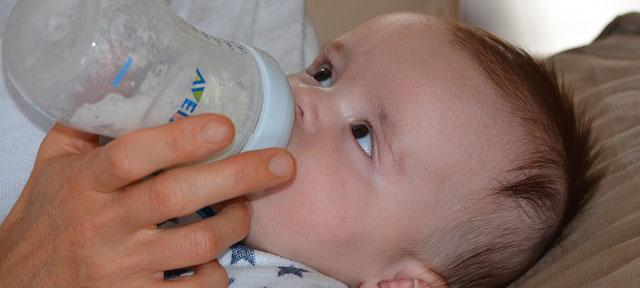Food and nutrition
Bottle feeding

Key information on this page includes:
Bottle feeding
Some mothers breastfeed, some mothers use infant formula milk and some mothers do both.
Introducing infant formula will reduce the amount of breast milk you will produce. This may make breastfeeding more difficult.
For more information on formula feeding click here Formula Feeding: Midlands Partnership University NHS Foundation Trust
What will I need to bottle feed?
If you are going to bottle feed with formula or expressed milk, you will need some items to get you started:
- 4-5 bottles with teats
- A bottle brush
- Sterilising equipment, either a steam steriliser, microwave steriliser or cold water sterilisation solution
Bottles and teats need to be thoroughly sterilised until your baby is 12 months old.
How do I make up formula?
A new born baby will need first milk - they can continue to have first milk until they are 1 year old.
You can buy pre-mixed baby formula in supermarkets; however these are more expensive than buying powdered formula that needs to be made up.
To make formula milk:
- Fill the kettle with fresh tap water (do not use water that has been boiled before).
- Boil the water, then let it cool for no more than 30 minutes, so that it remains a temperature of at least 70 degrees celsius.
- Clean and disinfect the surface you are going to use.
- Wash your hands to ensure cleanliness.
- If you are using a cold-water sterilizer, shake off any excess solution from the bottle and teat or rinse them with cooled boiled water from the kettle - not tap water.
- Place the bottle on the cleaned, disinfected surface.
- Follow the manufacturer's instructions and pour the appropriate amount of water into the bottle. Always add the water first while it is still hot, before adding the powdered formula.
- Loosely fill the scoop with formula powder according to the manufacturer's instructions, then level it using either the flat edge of a clean, dry knife or the provided leveller. Only use the scoop that comes with the formula.
- Put the teat into the retaining ring, ensuring it is secure, and then screw the ring tightly onto the bottle.
- Cover the teat with the cap and shake the bottle until the powder is fully dissolved.
- Cool the formula so it's not too hot to drink by holding the bottle (with the lid on) under cold running water.
- Test the temperature of the formula on the inside of your wrist before feeding it to your baby. It should be body temperature, which feels warm or cool but not hot.
- If there is any unused made-up formula left in the bottle after a feeding, discard it.
These steps are essential for making sure that formula milk is prepared safely and at the right temperature for an infant. Always follow the manufacturer's instructions on the formula packaging and consult with a health care professional for guidance on feeding your baby.
Make sure you follow the manufacturer's instructions as different brands use different amounts of water and powder.
Don't add more formula powder. As this can make your baby constipated. Do not add too much water as your baby needs the right amount of calories and nutrients.
Do not add anything to your baby's formula.
Do not use a microwave to heat feeds as hot spots can burn your baby.
Throw unused formula away.
Make up feeds as you need them to avoid tummy upsets.
Do not use bottled water to make up formula.
Combination feeding
Reasons to combine breast and bottle feeding
- Expressed breast milk: If you are breastfeeding and want to use a bottle to offer your baby some expressed breast milk.
- Mix of feeds: If you want to breastfeed for some of your baby's feeds but give bottles of formula for one or more feeds.
- Transition from bottle feeding; If you are bottle feeding your baby and want to start breastfeeding.
- Temporary separation: If you need to leave your baby and want to ensure they have some milk while you're away.
Introducing formula feeds
When introducing formula feeds alongside breastfeeding, consider the following:
- Gradual transition: It's best to introduce formula gradually to give your body time to reduce the amount of milk it produces. This can help lower the chances of experiencing discomfort, swollen breasts or mastitis.
- Planning for returning to work: If you're planning to go back to work, start introducing formula feeds a few weeks beforehand to give both you and your baby time to adjust.
- Alternative to bottles: If your baby is 6 months old or more and can drink milk from a cup, you may not need to introduce a bottle at all.
Giving your baby their first bottle
It may take some time for a breastfed baby to get used to bottle feeding. Consider the following tips:
- Choose the right time: It's often helpful to give the first few bottles when your baby is happy and relaxed, not when they are very hungry
- Different caregiver: Having someone else give the first bottle feeds can be beneficial, as it prevents your baby from smelling your breast milk and may reduce confusion.
- Change positions: You might want to try using a different position for bottle feeding compared to breastfeeding.
Breastfeeding more and reducing bottles
If you want to increase breastfeeding and reduce the number of bottles, here are some tips:
- Skin-to-skin contact: Hold and cuddle your baby as much as possible, ideally skin-to-skin as this encourages your body to make more milk and promotes breastfeeding.
- Regular breast milk expressions: Express your breast milk regularly to stimulate milk production. Your midwife, health visitor, or a breastfeeding supporter can show you how to do this.
- Bottle feeding close to the breast: Try bottle feeding while holding your baby skin-to-skin and close to your breasts to maintain a connection.
- Frequent feeding: If your baby is latching on, feed often. It's normal if your baby doesn't feed for extended periods initially.
- Right timing: Choose times when your baby is relaxed, alert, and not too hungry for breastfeeding, and don't force your baby to stay at the breast.
- Gradual reduction: Decrease the number of bottles gradually as your milk supply increases.
- Lactation aid: Consider using a lactation aid (supplementer) to support your baby's transition to breastfeeding. This tiny tube is taped next to your nipple and passes into your baby's mouth so they can get milk from the tube as well as from your breast.
Consult with your midwife, health visitor, or a breastfeeding supporter for guidance and support in managing mixed feeding and ensuring a smooth transition between breast and bottle feeding for your baby
